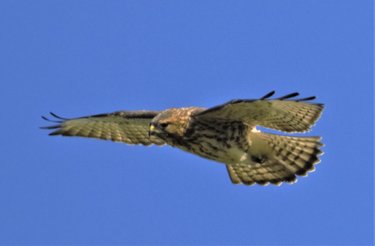A total of 1,915 migrating raptors were counted over Thacher Park this year
To the Editor:
The annual fall diurnal raptor migration (of hawks and daytime birds of prey) through the Capital Region as observed and documented by the Helderberg Escarpment Hawk Watch at the John Boyd Thacher State Park’s overlook has historically been centered around Sept. 15.
Statistics and personal accounts dating back to the early 1980s have tended to reinforce this date. Over the past five years, our local peak days have varied from Sept. 15 and 22 in 2015, the 17th and 19th in 2016, the 12th in 2017, the 19th in 2018, and the 13th this year (683 raptors/587 BW).
Conjecture at the site has been that, despite the variation of the migration peak date, warmer weather seems to delaying the bulk of the migration by about a week in recent years. Hawk Migration Association of North America/NorthEast Hawk Watch, our national affiliates, proclaimed Sept. 22, 2018 as the average peak date for all of its 41 member sites in the Northeast/New England region in its published annual report on the 2018 raptor migration.
This year, our neighboring site to the east at Wachusetts Mountain in Massachusetts peaked on Sept. 16. Franklin Mountain in Oneonta peaked on Sept. 15. And Hawk Mountain in Pennsylvania peaked on Sept. 16.
So much for conjecture and consistent consensus when raptors and the weather are concerned.
For our concentrated 102-hour/16-day raptor count this year, over 3,496 park visitors contributed to our observation effort. We observed 98 black vultures, 201 turkey vultures, 16 osprey, 52 bald eagles, 3 northern harriers, 30 sharp-shinned hawks, 33 Cooper’s hawks, 3 red-shouldered, 1,181 broad-wings, 112 red-tails, 1 tentative golden eagle, 16 American kestrels, 9 merlins, 23 peregrines, and 137 unidentified raptors — for a total of 1,915.
We also observed 1,158 monarch butterflies on their way to Mexico. It was an exciting, encouraging year for Danaus plexippus.
Some of these raptor numbers are skewed and inflated a bit by a recently introduced institutional bias. The original mission of the Helderberg Escarpment Hawk Watch was to educate the public about the thrill and ecological significance of the annual fall raptor migration through the Capital Region and to document raptor migration numbers for scientific purposes.
This goal has been accomplished and the Hawk Watch is in the process of transitioning into a more park-visitor oriented, less statistically focussed site. Over the past 18 years, the statistical validity and reliability of this site relative to neighboring sites has been documented and verified.
As members of the general birding community have grown in their contribution to this site in terms of time and energy, the emphasis has moved from the strict migration protocol of noting only migrating raptors who cross a designated geographic line to observation and education of the public via noting every instance of a bird, even if it’s multiple sightings of the same bird over the course of the day.
And that is a fine thing, especially for those park visitors interested in observing a larger number of birds than just migrants. Over the next two years, approaching our XXth anniversary, I myself will be looking forward to spending more time observing and enjoying the winged spectacle — and less time with my head down and logging data.
In short, our emphasis will be shifting from data collection for Hawk Migration Association of North America/NorthEast Hawk Watch purposes to a more educational role supported by local chapters of the National Audubon Society and the Hudson Mohawk Bird Club with daily observations being made more readily available through Audubon and Cornell ‘ebird.org’ websites.
Yahoo! It’s an exciting time.
Thank you to Luciano Toffolo for his 102-hour/16-day dedication to spotting, photographing, identifying, and logging migrating raptors. Truly amazing, much appreciated work.
Also supporting the effort observing and educating were: Tom and Colleen Williams and friends from the Hudson Mohawk Bird Club, Marian Sole and her associates from the Alan DeVoe Bird Club of Columbia County, as well as photographer/spotter/identifier Curt Morgan and educator extraordinaire Sue Breslin.
With the help of these members and others of the Helderberg Escarpment Hawk Watch team, the daily numbers for raptors observed can be seen on Cornell’s ‘ebird.org’ website. Information and pictures are also available on the Helderberg Escarpment Hawk Watch Facebook page: https://www.facebook.com/HelderbergEscapmentHawkWatch/, thanks to John Loz.
Thanks to Richele Ford and her live raptor presentation at our Sept. 7, 2019 migration event — always enjoyable and educational.
Thank you to Nancy Engel of the J.B. Thacher Park Emma Treadwell Nature Center for her support and contribution to the effort. Good to see you at the festival Sept. 7.
Next year's festive event number XIX will be held on Sept. 12, 2020 at the Thacher Park overlook.
Keep looking up.
Will Aubrey
Helderberg Escarpment
Hawk Watch

